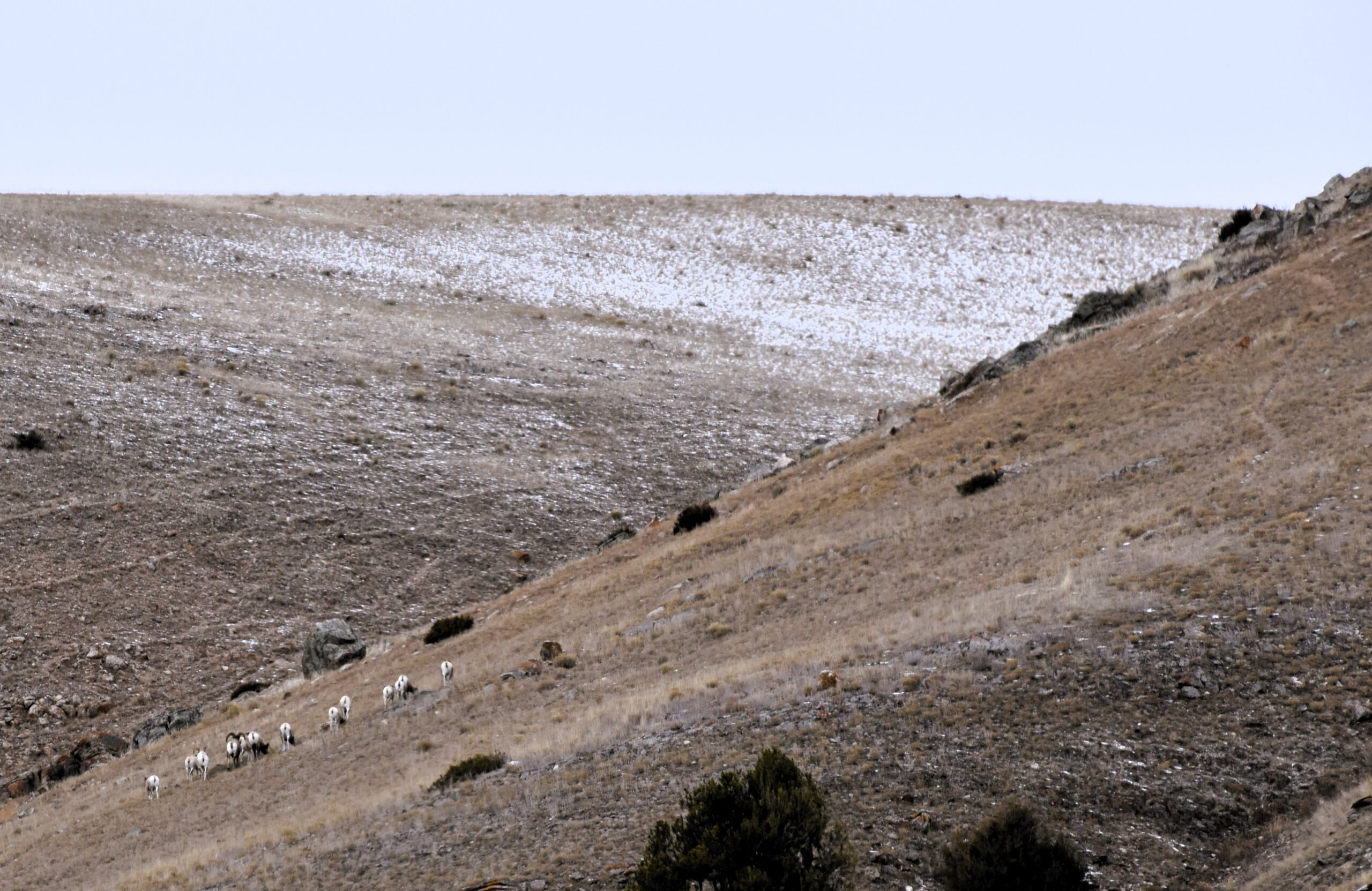Species Spotlight: Bighorn Sheep
Discovering the Winter Wonders of Miller Butte: A Bighorn Sheep Stronghold in Jackson HoleBLOG
By Kyle Kissock | Jackson Hole Wildlife Foundation
Jackson Hole, Wyoming, is a treasure trove for wildlife enthusiasts, especially during the winter months. If you’ve never witnessed majestic bighorn sheep in their natural habitat, Miller Butte is the place to be. Here’s your guide to an unforgettable experience along the National Elk Refuge Road!

A herd of bighorn sheep on the south side of Miller Butte, camouflage given away by their white rumps. This butte serves a low-elevation winter grounds for this herd, which summers in the Gros Ventre high country.
Getting There: A Winter Wonderland Drive
Start your adventure by driving along the National Elk Refuge Road, approximately 1.5 miles from its starting point. As you navigate this picturesque route, a rocky bluff known as Miller Butte will rise on your left. In the winter, the road along the base of the butte stays open to the public for 3.5 miles, offering an opportunity to spot Bald Eagles, elk, coyotes, and occasionally, elusive wolves.

An easy way to help wintering wildlife is by following all regulations set by the U.S. Fish and Wildlife Service while visiting the National Elk Refuge. These rules are in place for your safety and to help wildlife make it through winter!
Meet the Bighorn Sheep: Wyoming’s Magnificent Migratory Ungulates
The biggest draw of Miller Butte is its wintering population of Bighorn sheep. Bighorn sheep, one of Wyoming’s eight species of ungulates, are a captivating sight. Male bighorn sheep, known as rams, boast impressive sets of curved horns that grow larger with each passing year. These horns are not just a spectacle; they serve as symbols of rank during head-to-head combat between males, especially during the breeding season when rams vie for mating rights.
Bighorn sheep often form matrilineal social groups, led by females (called ewes), which establish individual home ranges. Rams, less tied to specific groups, travel between different groups. After separating from the herd to give birth, ewes will often introduce young sheep back into the group, where lambs will be watched over collectively in a sort of “community nursery.” In the wild, bighorn sheep typically live between 9 to 13 years.
Winter Social Scene: Witnessing Bighorn Sheep Behavior
While observing bighorn sheep on Miller Butte during winter, you might witness head-butting behavior among some of the sheep. Contrary to the breeding season, this behavior is likely social in nature, serving as a form of play or an establishment of rank among younger members of the herd.
As of December 27th, 2023 at least 40 bighorn sheep have been reported in the vicinity of Miller Butte. These sheep exhibit seasonal migrations, with winter drawing them to the lower elevation of the National Elk Refuge after spending the summer dispersed in the nutrient-rich alpine environment of the Gros Ventre Mountains.

While both male and female Bighorn sheep have horns, this ewe (female) can be distinguised by horns which are smaller, consistant in width, and less curved.
Conservation Efforts and Challenges: Protecting Bighorn Sheep Populations
The historical range of bighorn sheep once stretched across the entire Mountain West from Canada to Mexico. However, today’s bighorn sheep populations face challenges such as a continued rebound from historic overhunting, diseases (wild sheep are susceptible to pneumonia spread by domestic livestock), and habitat loss. While Wyoming’s bighorn sheep population has partially recovered, it still falls below the objectives set by the Wyoming Game and Fish Department. Today’s estimated population ranges between 6,000 and 7,000 individuals.

According to a biologist, as of December 27th, 2023 at least 40 bighorn sheep have been reported in the vicinity of Miller Butte.
You Can Help
Responsible Viewing and Conservation
You can play a role in supporting bighorn sheep conservation efforts. When visiting Miller Butte, ensure you give these magnificent creatures ample space. Drive cautiously along the road, as the sheep near Miller Butte can become habituated and may approach humans out of curiosity. It’s also crucial to resist the temptation to let them lick your vehicle (sheep are attracted by road salt smattered on the sides and bottom of cars), as this could enhance the spread of diseases. Be a responsible observer, appreciating these incredible animals while prioritizing their well-being.
